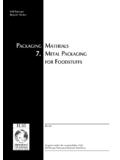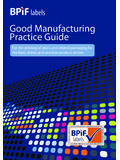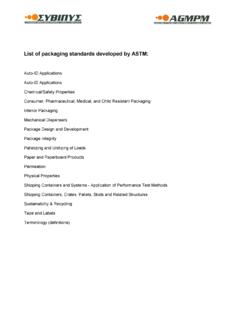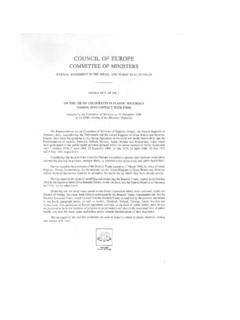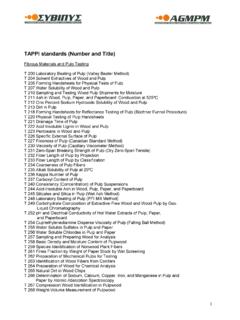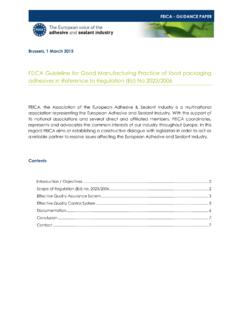Transcription of Migration testing of adhesives intended for food …
1 FEICA - GUIDANCE PAPER Brussels, 27 May 2016 Migration testing of adhesives intended for food contact materials FEICA, the Association of the European adhesive & Sealant Industry, is a multinational association representing the European adhesive and sealant industry. With the support of its national associations and several direct and affiliated members, FEICA coordinates, represents and advocates the common interests of our industry throughout Europe. In this regard, FEICA aims to establish a constructive dialogue with legislators in order to act as a reliable partner to resolve issues affecting the European adhesive and sealant industry.
2 Introduction This guidance paper forms part of a package on Migration testing of non-plastic food contact materials developed by several sector associations from the packaging supply chain. This document outlines the specific guidelines for conformity testing of adhesives as components of food contact materials. To learn more about the guidance papers of the other sectors, refer to the information on the FEICA website at: FEICA Guidance Paper | GUP-EX-F03-010 Page 2 of 12 Content Introduction .. 1 1. 3 2.
3 Typical adhesive systems used in food contact applications .. 3 Reactive polyurethane (PU) adhesives .. 3 adhesives based on natural 4 Dispersions / emulsions: adhesives based on vinyl acetate polymers (PVAc) or ethylene vinyl acetate (EVA) copolymers .. 4 Dispersions / emulsions: adhesives based on acrylic polymers and copolymers, including styrene acrylate terpolymers and reactive systems .. 4 Cold seals .. 4 Heat seals .. 5 Hotmelt adhesives .. 5 3. Material-specific properties to be considered when testing this class of FCM .. 5 Reactive polyurethane (PU) adhesives .
4 5 adhesives based on natural 6 Dispersions / Emulsions: adhesives based on vinyl acetate polymers (PVAc) or ethylene vinyl acetate (EVA) copolymers .. 7 Dispersions / emulsions: adhesives based on acrylic polymers and copolymers, including styrene acrylate terpolymers and reactive systems .. 7 Cold seals .. 7 Heat seals .. 7 Hotmelt adhesives .. 8 4. Test procedures and evaluation of test results .. 8 Reactive polyurethane (PU) adhesives .. 9 adhesives other than reactive polyurethane (PU) adhesives .. 11 5. References .. 12 6. contact .
5 12 FEICA Guidance Paper | GUP-EX-F03-010 Page 3 of 12 Format for Material-Specific Guidelines for Conformity testing Chapter 2: adhesives 1. Scope This chapter outlines specific guidelines for conformity testing of adhesives as components of food contact materials. adhesives typically make up less than 5% of the packaging and, for most adhesive applications, direct food contact is not intended1. Depending on the adhesive and application, contact may occur unintentionally at seams and edges, or via Migration through the packaging or gas phase due to volatile compounds (vapour phase transfer).
6 Consequently, specific Migration of individual compounds is of greater interest than overall Migration , as the latter is only a measure of inertness and has no toxicological meaning. Following the requirements of Regulation (EU) No. 1935/2004, the finished food contact material has to be tested and / or evaluated under real use conditions. testing the adhesive alone can only be considered as a screening tool and should only be used in cases where the worst-case calculation fails or cannot be carried out due to missing information. For more details of how to select a suitable adhesive for application in food contact materials, please consult the FEICA Guidance for a food contact status declaration for adhesives2 Tests according to the rules of the plastics regulation on the pure adhesive without substrate or the construction material will usually overestimate the Migration of constituents into foodstuff, as contributing factors to real Migration are not sufficiently considered.
7 Contributing factors can be: Curing times and conditions Interaction of adhesive with other FCM layers Barrier properties of other FCM layers3 Distribution of constituents within the FCM Ratio of adhesive amount to filling good 2. Typical adhesive systems used in food contact applications Due to the wide range of applications and the complexity of the chemistry, no unified testing conditions can be defined for adhesives (see References for further details). Therefore, in many cases the conditions defined in Regulation 10/2011 for plastics cannot be applied to adhesives .
8 The following types of adhesives with their typical applications are defined4. Reactive polyurethane (PU) adhesives Reactive polyurethane adhesives are composed of one or two components (solvent-based, solvent-free or water-based) and are predominantly used for lamination of polymer films. In addition to pure polymer material, the layers of the finished laminate may consist of metallised films or other materials such as aluminium, paper, etc. Proper curing conditions according to the recommendations of the adhesive manufacturer have to be ensured.
9 1 With the exception of heat and cold seals and pressure sensitive for direct food labelling 2 3 The barrier properties of the different FCM layers are not within the scope of this guideline. More information on barrier properties of different materials can be found in the Migration testing guideline for plastics. 4 Microwave and ovenable applications are not considered in this document. FEICA Guidance Paper | GUP-EX-F03-010 Page 4 of 12 The application ranges of the finished article encompasses all types of foodstuffs, including prolonged storage (> 6 months) and temperature conditions from cooled storage (below 0 C) up to retort conditions ( 135 C).
10 adhesives based on natural polymers adhesives based on natural polymers are water-soluble adhesives such as dextrins or starches and are mainly used for, but not limited to, the paper and cardboard packaging of dry foodstuff and for secondary / tertiary packaging. In combination with natural protein, starches and dextrins may be used for bottle labelling. They are also used as wet laminating adhesives in the construction of foil to paper for spiral wound tubes and for paper/foil lidding. Dispersions / emulsions: adhesives based on vinyl acetate polymers (PVAc) or ethylene vinyl acetate (EVA) copolymers Vinyl acetate polymers (PVAc) and ethylene vinyl acetate (EVA) copolymers are applied as dispersions, emulsions or water-soluble adhesives .

